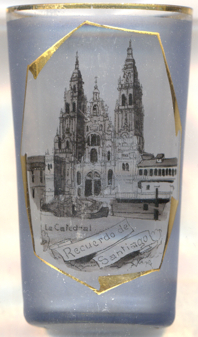

|
| ESPAÑA | Spain |
| Galicia | |
| Provincia da Coruña |
Santiago de Compostela, the capital of the autonomous community of Galicia in northwestern Spain, is situated at an elevation of 260 m in the province of A Coruña. The city has its origin in the shrine of Saint James the Great as the destination of the Way of St. James, a leading Catholic pilgrimage route since the 9th century. The municipality has a population of about 97,300 (2019). The old town of Santiago de Compostela was listed as a UNESCO World heritage Site in 1985. In 2000, it was one of the European Capitals of Culture together with Avignon, Bergen, Bologna, Brussels, Helsinki, Kraków, Prague and Reykjavík.
 The area of Santiago de Compostela was a Roman cemetery by the 4th century and was occupied by the Suebi in the early
5th century. The area was later attributed to the bishopric of Iria Flavia in the 6th century. The bishopric was
incorporated into the Kingdom of Asturias around AD 750. At some point between 818 and 842 it was claimed that the
remains of Saint James the Greater had been found here. Around the place of the discovery a new settlement and centre of
pilgrimage emerged, which was called Compostella by the 10th century. According to some authors, the site
had already become a pan-European place of peregrination by the mid-11th century. In the 12th century Compostela became
an archbishopric. Santiago de Compostela was captured and sacked by the French during the Napoleonic Wars; as a result, the
remains attributed to the apostle were lost for nearly a century, hidden inside a cist in the crypts of the cathedral.
The area of Santiago de Compostela was a Roman cemetery by the 4th century and was occupied by the Suebi in the early
5th century. The area was later attributed to the bishopric of Iria Flavia in the 6th century. The bishopric was
incorporated into the Kingdom of Asturias around AD 750. At some point between 818 and 842 it was claimed that the
remains of Saint James the Greater had been found here. Around the place of the discovery a new settlement and centre of
pilgrimage emerged, which was called Compostella by the 10th century. According to some authors, the site
had already become a pan-European place of peregrination by the mid-11th century. In the 12th century Compostela became
an archbishopric. Santiago de Compostela was captured and sacked by the French during the Napoleonic Wars; as a result, the
remains attributed to the apostle were lost for nearly a century, hidden inside a cist in the crypts of the cathedral.
The  cathedral of Santiago de Compostela [left, no. 3896]
is the reputed burial place of the apostle Saint James the Great. It is one of the only three churches in the world built
over the tomb of an apostle, the other two being St. Peter's Basilica in Vatican City and
St. Thomas Cathedral Basilica in Chennai, India. The cathedral has historically been a place of pilgrimage on the Way
of St. James since the Early Middle Ages and marks the traditional end of the pilgrimage route. According to the
legend, the first chapel was built after AD 814. This was followed by the first church in AD 829 and then in
AD 899 by a pre-Romanesque church. This church was destroyed by the troops of the caliph of Córdoba in
AD 997. Construction of the present cathedral began in 1075. It was built according to the same plan as the basilica
of St. Sernin in Toulouse. Although certainly not finished, the church was consecrated in 1211. When Santiago de
Compostela became an episcopal see in 1075, the church became a cathedral. Due to its growing importance as a place of
pilgrimage, it was raised to an archiepiscopal see in 1100. The cathedral was expanded and embellished with additions in
the 16th, 17th and 18th centuries. The western façade (façade of the Obradeiro) [shown on glass
no. 3896] was created in the 18th century in Baroque style. The stars in front of this part of the church
had been created in the 17th century in Renaissance style.
cathedral of Santiago de Compostela [left, no. 3896]
is the reputed burial place of the apostle Saint James the Great. It is one of the only three churches in the world built
over the tomb of an apostle, the other two being St. Peter's Basilica in Vatican City and
St. Thomas Cathedral Basilica in Chennai, India. The cathedral has historically been a place of pilgrimage on the Way
of St. James since the Early Middle Ages and marks the traditional end of the pilgrimage route. According to the
legend, the first chapel was built after AD 814. This was followed by the first church in AD 829 and then in
AD 899 by a pre-Romanesque church. This church was destroyed by the troops of the caliph of Córdoba in
AD 997. Construction of the present cathedral began in 1075. It was built according to the same plan as the basilica
of St. Sernin in Toulouse. Although certainly not finished, the church was consecrated in 1211. When Santiago de
Compostela became an episcopal see in 1075, the church became a cathedral. Due to its growing importance as a place of
pilgrimage, it was raised to an archiepiscopal see in 1100. The cathedral was expanded and embellished with additions in
the 16th, 17th and 18th centuries. The western façade (façade of the Obradeiro) [shown on glass
no. 3896] was created in the 18th century in Baroque style. The stars in front of this part of the church
had been created in the 17th century in Renaissance style.
[https://de.wikipedia.org/wiki/Santiago_de_Compostela, https://en.wikipedia.org/wiki/Santiago_de_Compostela;
https://en.wikipedia.org/wiki/Santiago_de_Compostela_Cathedral]
![[scale]](lineal.jpg)